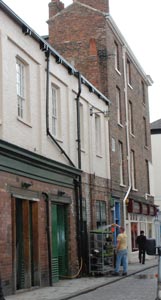

- Built in the beginning of 1900's
- Two story brick building with thick walls.
- Area 1000 m2
- Property type: Office building, former police station and electrical centre
Differential settlement of a Victorian city center building caused headaches for York City Council recently – and they turned to us for a solution because of the company’s track record in keeping disruption to a minimum. PowerPile installed their new PowerPile system, which injects expanding resins into geotextile tubes to improve bearing pressure and strengthen the ground beneath subsided foundations. Archaeological considerations were another factor, with concern to minimize disturbance to the ground under the building.

The two-story brick building was originally a police station of heavy construction. Nine-inch thick York stone slabs formed the first floor and part of the ground floor. In the 1930s the building was converted into an electricity substation, containing very heavy transformers and electrical switchgear. Although this has now been decommissioned and the equipment removed, the heavy weight was possibly an exacerbating factor increasing the settlement, says Mark Whitelock, Senior Engineer for York Consultancy, consulting engineers for the City Council."The building was only on brick spread footings, which were relatively shallow, and these were resting on soft ground. The original ground level is approximately 5-6 metres below the current ground level, and the intervening ground is Roman and medieval fill which can be extremely soft organic material.
"Subsidence has been occurring for at least 15-20 years, but in recent years has accelerated. So we were faced with the problem of having to underpin and stabilize the building."
In reviewing the various options, major consideration was given to the building’s location in the city center, surrounded on three sides by shops and offices, with three sides being party walls.York Consultancy chose us because, says Whitelock,
"the alternatives were just too problematic, using mini piles, or needles, or lintels under the walls. PowerPile process is quieter, and it’s easier on site – there are no excavations, so there isn’t lots and lots of spoil coming to the surface. Plus it’s quicker. This work will take about 4 weeks, but with traditional methods it would be more like 3-4 months with a lot more disruption, a lot more dirt, a lot more noise, and a lot more cost. Everything was stacked against putting in a traditional system."
We have previously worked with York Consultancy to stabilize council houses using the Slab Lifting and power injection technologies. Fast-expanding resins are injected through copper tubes inserted into small diameter holes under the flooring, filling voids, stabilizing fill material, and also strengthening the ground at depth where foundations have subsided. Archaeological factors led to recommend the use of the PowerPile system as it would constrict the spread of resin. At the request of York Archaeological Trust, two test piles were installed before the go-ahead was given for the project.
PowerPile is ideal for use in weak ground, as it contains and precisely locates the expanding polymer resins in geotextile tubes and can produce an up to 600% increase in ground bearing pressure without excavations.
Whitelock is impressed with the results.
"When we excavated the test piles, I was expecting to be able to push my finger into the resins, but they were like concrete. It was remarkable. Being constricted by the tubes gives the resins a greater density."
PowerPiles are currently being installed under all the internal walls of the building, with the project due for completion at the end of May.
PowerPile geopolymer pillar is an internationally patented technology for ground improvement and structural support.